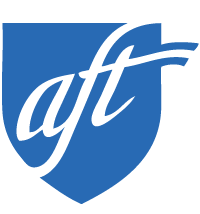AI is a) powerful, b) perilous or c) both
Educators are confronting a juggernaut that is swiftly revolutionizing education and society: generative AI.

Weingarten, second from left, and other leaders at the AI Insight Forum hosted by Senate Majority Leader Chuck Schumer on Sept. 13. Courtesy of Randi Weingarten
It’s a head-spinning time to be an educator in the United States. From the difficulties of teaching during a pandemic, to getting caught in the crosshairs of culture wars, to doing everything in their power to help students recover and thrive academically and emotionally—all while being underpaid, and often in inadequate learning and teaching conditions—teachers have gone from one challenge to the next. Now, educators are confronting a juggernaut that is swiftly revolutionizing education and society: generative AI. And they are largely figuring it out without any guidance, including from their schools and districts. The AFT is advocating for policies that will help maximize the benefits and limit the perils of AI, and we are offering educators tools and guidance to prepare their students for this new world.
The possible uses of artificial intelligence systems are limitless. AI can be used to detect and treat cancer—or to deceive voters and disrupt elections. The range is broad in education as well. Potential benefits of AI in education include learning personalized to each student, data analysis to improve teaching methods, reducing onerous paperwork for teachers, and engaging students in learning in new and exciting ways. AI could lessen the burden of one of the most time-consuming tasks for teachers: giving meaningful feedback on students’ writing. Teachers who assign students to write papers can outsource correcting grammar and spelling to AI, saving the human touch to evaluate students’ arguments and analyses.
But there are downsides. The COVID-19 pandemic shined a spotlight on America’s gaping digital divide, and without extensive changes to education funding, these new technologies will only deepen that divide. Racial and cultural bias is a well-documented problem in AI algorithms, and data privacy is a serious concern. AI raises thorny ethical issues around plagiarism and cheating, and it can exacerbate the already widespread loneliness and disconnection among young people.
Teachers aren’t Luddites; they already embrace using technology in their craft. The recent AFT Surveys of Teachers and Parents on Educational Technology found that more than three-quarters of preK-12 teachers use education technology daily in communication (77 percent), planning and preparation (71 percent), and whole-class or large-group instruction (65 percent). But there is concern about students’ social media use. Three-quarters of teachers believe that students’ social media use has a negative impact on them, and a similar percentage of parents say it has a negative or mixed impact on their children.
Social media platforms have failed to protect our young people from the nefarious practices of technology companies. And government officials have not done enough either. Social media, generative AI and machine learning models must be developed and employed ethically, with developers held accountable for any real-world harm. There are now virtually no checks on the power of generative AI models, but there is a broad consensus among corporations, governments and civil society that guardrails are needed. Governments must implement effective regulations protecting privacy, security and well-being. And social media and AI technologies must adhere to principles of equity, fair access and social accountability.
We are working to help educators help their students develop critical-thinking and analytical tools, including discerning facts from falsehoods. The AFT has a new partnership with GPTZero, the leading AI identification platform, and we have strengthened our media literacy partnership with NewsGuard, an anti-misinformation tool, offering both as resources for classroom educators. Our goal is to promote media and news literacy, as well as to give educators robust assistance in using AI in their classrooms and helping their students use AI technology effectively. All AFT members will have priority access to a series of new tools developed for pedagogical AI teaching. Members will also be able to access codes to enable their students, colleagues and families to use both GPTZero and NewsGuard at no cost at newsguardtech.com/aft. It’s the latest in the AFT’s Real Solutions for Kids and Communities campaign.
We need more partnerships like this with educators, policymakers and industry leaders, and we must act now. While state education leaders and school districts are “studying” the issue, AI developers are moving full speed ahead. Education and government officials have an obligation to adapt with the fast-changing effects of technology on students, educators, teaching and learning. This will require new investments, high-quality professional development, accountability measures, safeguards, and acknowledgments that technology should supplement, not supplant, educators.
Like many others, I regard new technologies like generative AI with a mix of awe and apprehension. I am excited by how they could benefit health, science and the environment. I worry about the potential to undermine elections and democracy itself, as well as warnings from scientists and experts about the risk of human extinction from AI. Today’s students need to be equipped for all of this—to harness the good and prevent the harm of new and future technologies. We must support their teachers to help them navigate the complexity of their changing world.













